Iran Faces Internal Woes And Outside Interference
By Brian E. Muhammad -Staff Writer- | Last updated: Jan 11, 2018 - 1:25:03 PMWhat's your opinion on this article?
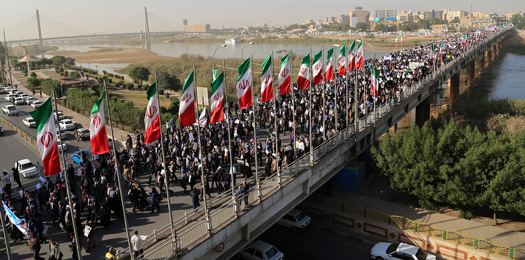
In this photo provided by Mehr News Agency, demonstrators attend a pro-government rally in the southwestern city of Ahvaz, Iran, Jan. 3. Tens of thousands of Iranians took part in pro government demonstrations in several cities across the country on Jan. 3, Iranian state media reported, a move apparently seeking to calm nerves after a week of protests and unrest that killed at least 21 people. Photo: AP/Wide World photos
|
Days of protests throughout the Islamic Republic of Iran in late December raised questions about the root cause of the street demonstrations.
Domestic dissatisfaction and economic tension in the country appears to connect to the demonstrations. However, leaders of the Islamic Republic also blame foreign meddling in the internal affairs of Iran as a factor in the violent expressions of dissent.
“Of course, we don’t deny that there are some economic issues … which should be resolved through the proper channel,” said Mehdi Atefat, director of the Interests Section of the Islamic Republic of Iran in Washington, D.C.
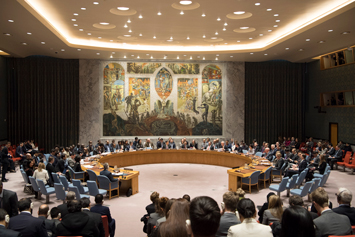
General view of the Security Council as it meets to consider the situation in Iran, Jan. 5, United Nations, New York. Photo: UN Photo/Eskinder Debebe
|
In a Final Call exclusive interview, Ambassador Atefat pointed out internal problems exist in Iran like any other nation, including the United States, France, Saudi Arabia and Israel. Demonstrations occur in these nations where some have turned chaotic, Ambassador Atefat said. He placed blame on media spinning narratives that support one side and demonize the other.
“When it comes to Iran, so sudden the media wants to change the course and say the people are against the regime or they are for regime change, but if the same thing happens in France, this is normal … this is freedom … land of opportunity… (where) everybody has a voice,” Ambassador Atefat observed.
According to IRN news agency, Iran Foreign Minister Javad Zarif said via twitter Jan. 5: “eternal bedfellows’ Saudi Arabia and the terrorist group Daesh are supporting violent unrests in Iran under the leadership of the U.S. President Donald Trump.”
Amb. Atefat said Iranian security forces captured groups entering Iran at the borders. “They captured them with their many heavy ammunitions,” he said. They were attempting to blend among the people as provocateurs, he charged.
Through Western media outlets like Voice of America and the British Broadcasting Corporation images of violence and mayhem was spread. But the Iranian government also noted pro-government demonstrations were held in support of the leadership.
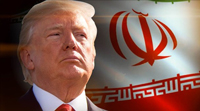
Donald Trump
|
“If they truly cared about the Iranian people they would not have run such a ruthless sanctions regime,” said Vijay Prashad, director of Tricontinental Institute for Social Research.
“The fake solidarity from Trump should be seen for what it is—the words of a man who drives an imperialist dynamic that seeks preponderant power for the United States and its allies,” argued Mr. Prashad in an analysis published on www.vijayprashad.org.
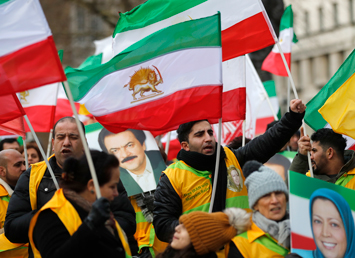
The Anglo-Iranian communities, supporters of Iran's democratic opposition, the National Council of Resistance of Iran (NCRI) and main organized opposition movement PMOI, held a rally opposite the entrance of 10 Downing Street in London, Jan. 4, in solidarity with the nationwide anti-regime protests in Iran.
|
Geopolitically Iran was out in the cold until a 2015 agreement was etched out with the P5 + 1—the UN Security Council’s five permanent members; namely China, France, Russia, the United Kingdom, the United States plus Germany. The agreement is at the center of conservative controversy in the U.S. and President Trump has vowed to reverse it.
The violent turn of protests is not surprising to some observers.
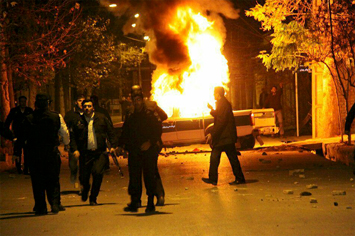
Iranian protester shot dead by Police during the demonstrators protesting high prices and the poor state of the economy under President Hassan Rouhani. Dorud, Lorestan Province, Iran, on December 30, 2017. Photo: AP.Wide World photos
|
But long before the protests, during a 2016 visit to Iran, a warning of U.S. government plots to disrupt and overthrow countries in the Muslim World was delivered by the Honorable Minister Louis Farrakhan of the Nation of Islam.
He advised Iranians to act “wise and careful.” Iran was in an election season at the time.
“Guide your country well and choose well whom you will put in positions of authority, because the enemy is among you already seeking to erode your revolution with a soft war,” said Minister Farrakhan.
The plans for disruption of the Middle East began in the U.S. Pentagon in the 1990s, a decade before 911 and death of nearly 3,000 people, Minister Farrakhan said.
The Muslim leader cited retired four-star Army General Wesley Clark who said he was made aware of plans to clean out the Middle East and take over Muslim countries.
Ten days after 911, Gen. Clark was shown a Pentagon memo with plans and a target list of seven Muslim countries to be destabilized, said the Minister. Iraq, Syria, Lebanon, Libya, Somalia, Sudan and Iran were on the list.
The Minister said much of the root of suffering in the Muslim world today is foreign meddling.
“Your problems that you had before have been amplified because an enemy has come among you and sowed poison between your already divided house and made some of you enemies of another that they may create civil war and destroy, particularly the revolution of Iran,” Minister Farrakhan said.
Some sanctions interfered with international trade and caused financial hardship, adding weight to domestic problems.
“It’s a country of nearly 90 million people,” said A. Akbar Muhammad, International Representative of the Nation of Islam. “A country that big you can’t expect that everybody are happy campers, just sitting down and things are fine,” he added.
Mr. Muhammad pointed out that Iran has tremendous oil wealth and is considered a major market for business. “People want to be involved with that market,” he remarked. However, some opportunity was stifled over the years by U.S. sanctions.
Coming out the political cold with the nuclear deal, there were lofty hopes for foreign investment and softening the effects of isolation, which didn’t fully happen.
“Iran’s government–led by Hasan Rouhani–had raised the expectations of the population when it negotiated the nuclear deal with the West and the United Nations,” said Mr. Prashad, in an article on Alternet.com.
“The sanctions cost Iran more than $160 billion in oil revenues since 2012. This penalty was borne by ordinary Iranians, who saw their standard of living fall and their aspirations for the future narrow,” wrote Mr. Prashad.
Instability and chaos will benefit the U.S.-led anti-Iran axis made up of America, Israel, Saudi Arabia and several other Muslim nations, said observers.
INSIDE STORIES AND REVIEWS
-
-
About Harriett ... and the Negro Hollywood Road Show
By Rabiah Muhammad, Guest Columnist » Full Story -
Skepticism greets Jay-Z, NFL talk of inspiring change
By Bryan 18X Crawford and Richard B. Muhammad The Final Call Newspaper @TheFinalCall » Full Story -
The painful problem of Black girls and suicide
By Charlene Muhammad -National Correspondent- » Full Story -
Exploitation of Innocence - Report: Perceptions, policies hurting Black girls
By Charlene Muhammad -National Correspondent- » Full Story -
Big Ballin: Big ideas fuel a father’s Big Baller Brand and brash business sense
By Bryan Crawford -Contributing Writer- » Full Story






 Click Here Stay Connected!
Click Here Stay Connected!








